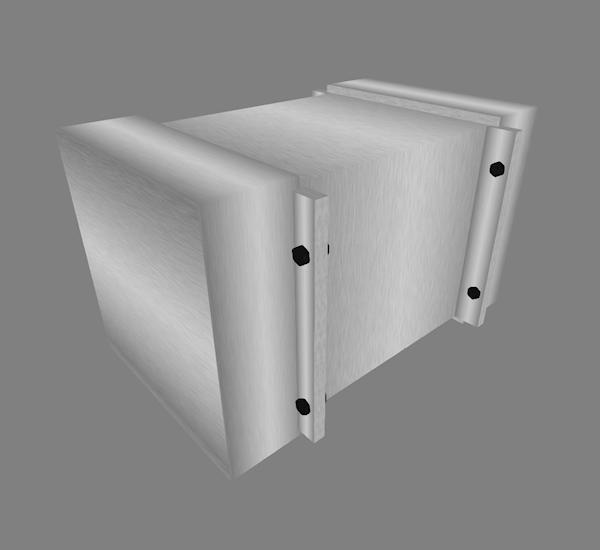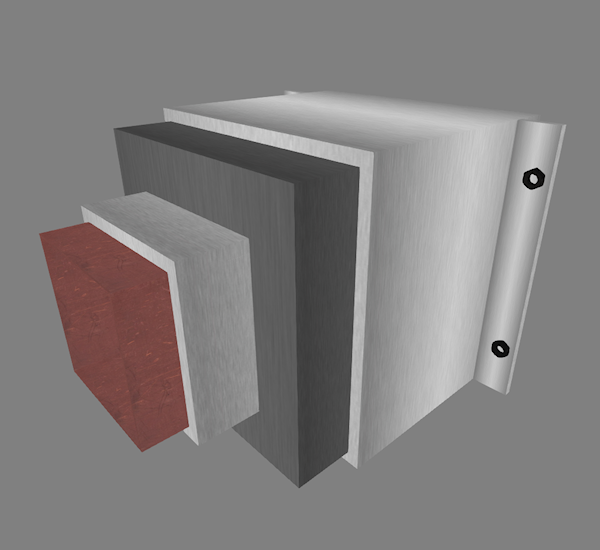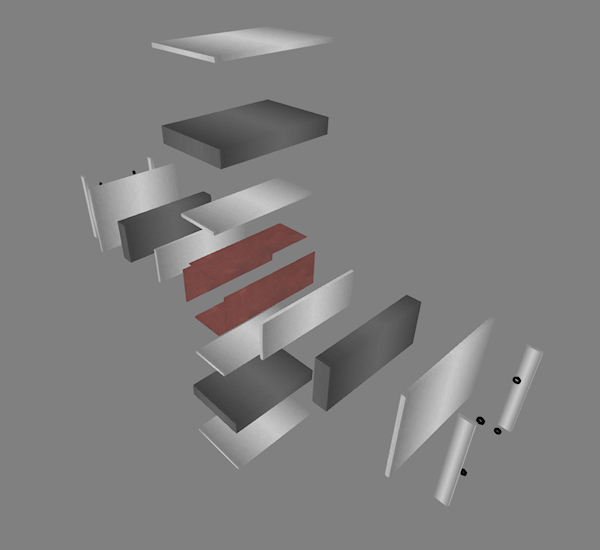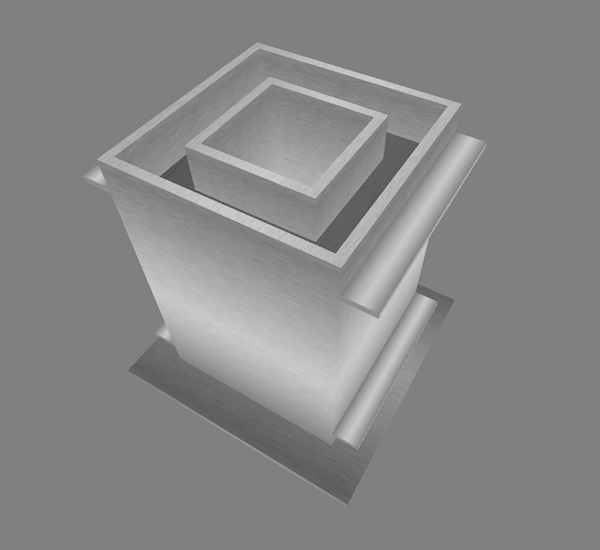DIY Radiation Shilded Chamber - for Gamma spectroscopy
9 months 18 hours ago #7259
by Simomax
DIY Radiation Shilded Chamber - for Gamma spectroscopy was created by Simomax
I want to build a radiation shielded chamber for Gamma spectroscopy using my Radiacode 103. After batting some ideas about on another thread this is what I have so far:
Complete chamber, assembled as if in use.
Chamber with both end caps detached.
Cut-away view of the chamber showing 6mm steel on the outside, then 25mm of lead, then another 6mm steel, and finally 0.5-1mm of copper sheet lining the chamber.
Exploded diagram of the chamber, for the nerdy.
Exploded diagram of an end cap, for the nerdy.
This picture shows the temporary plate on one end whilst filling with molten lead.
Whilst it is not lab grade, this should remove >90% of the background in the low energy range, which is ideal for sampling radioactive sources.
- Outer case is 6mm steel (mild steel) - This could be a square tube section, or made from sheet.
- Inner case is the same as the outer and has 60mm x 60mm to 75mm x 75mm (thereabouts) space in the center for the Radiacode and source.
- Internal length of the chamber will be ~200mm.
- Space between the inner case and outer case will be filled with lead, ~25mm thick.
- Tabs/flange on both caps and outer case to put bolts through to fix the end caps in place when it is being used. The bolts could be thumb turn screws or similar.
- Caps made to slide over the outer case with ~25mm lead in each end.
- 0.5-1mm copper lining the chamber walls and end caps.
Complete chamber, assembled as if in use.
Chamber with both end caps detached.
Cut-away view of the chamber showing 6mm steel on the outside, then 25mm of lead, then another 6mm steel, and finally 0.5-1mm of copper sheet lining the chamber.
Exploded diagram of the chamber, for the nerdy.
Exploded diagram of an end cap, for the nerdy.
This picture shows the temporary plate on one end whilst filling with molten lead.
Whilst it is not lab grade, this should remove >90% of the background in the low energy range, which is ideal for sampling radioactive sources.
Attachments:
Please Log in or Create an account to join the conversation.
- ChrisLX200
-

- Offline
- Elite Member
-

Less
More
- Posts: 161
- Thank you received: 8
9 months 17 hours ago #7260
by ChrisLX200
Replied by ChrisLX200 on topic DIY Radiation Shilded Chamber - for Gamma spectroscopy
Sounds good, although fabricating from flat plate seems a lot of work when you can buy rectangular tube fairly easily. Lots of choice on ebay. You could also perhaps re-purpose a metal project box for the outer if you have one lying around, the extruded aluminium ones often have screwed end plates. Can use a couple of 12" woodworking clamps to hold the thing together while the lead is poured. Just stuff I thought about while pondering my own solution. I'm still attracted to using round tubes as I already have material to hand. I found my stainless pots for melting solder but sadly nothing like a camping stove. I don't want to use my MAPP gas torch as that would waste a fair amount of expensive gas, so I guess I'll have to buy a cheap stove.
Please Log in or Create an account to join the conversation.
9 months 16 hours ago #7263
by Simomax
Agreed also about big clamps to hold a temporary plate on the bottom. I don't have any metal clamps large enough, only plastic ones. They are sure to get damaged. I do have access to some sash cramps though. They may work. Or I can just use some glue/silicone/some other sticky shmoo. It is only whilst the first layer of lead is poured. After that it shouldn't be an issue.. I understand you wanting to use tube. That's probably the easiest for you, but I have set my heart on a square construction now, for myself. The shape is kind of academic, if it suits it's purpose.
If you are going to buy a camping stove, have a look at those large blow torches too (something like this) . It might be better for you than a camping stove. You could cobble together some kind of stand on steel or bricks or something, wedge the torch nozzle somehow and use that. It would be much more efficient than a camping stove, and have other uses. I already have a stove, so I don't need to buy one. And with a blowtorch heating the top, it doesn't fair too bad, for occasional use, which is, very occasional.
Replied by Simomax on topic DIY Radiation Shilded Chamber - for Gamma spectroscopy
Agreed, it will be a lot of work. I have just had a quick look on ebay and after looking at a few listings I am unable to find square section with a 6mm wall. However when I was looking at round rube section, there were plenty with 1/4", which is what I have based my 6mm on, as this all stemmed from using round tube. I need to go and see my metal working friend and he will probably find the best solution, but the following criteria have to be met: Cost as low as possible, preferably free. He has tones (I mean literally, tons) of scrap metal laying about all over. He also has the big tools I'd need - hefty welder, saw etc. I'll probably go over a couple of Saturdays and just make it from bits laying around. It is more work, but I can make it exactly as I want, and for little to no cost. I'm happy to work more to spend less. The walls would only need 3 or 4 tacks to hold it together. The molten lead will fill any large gaps. And if it all goes to s**t, then hopefully I'll learn something!fabricating from flat plate seems a lot of work when you can buy rectangular tube fairly easily
Agreed also about big clamps to hold a temporary plate on the bottom. I don't have any metal clamps large enough, only plastic ones. They are sure to get damaged. I do have access to some sash cramps though. They may work. Or I can just use some glue/silicone/some other sticky shmoo. It is only whilst the first layer of lead is poured. After that it shouldn't be an issue.. I understand you wanting to use tube. That's probably the easiest for you, but I have set my heart on a square construction now, for myself. The shape is kind of academic, if it suits it's purpose.
If you are going to buy a camping stove, have a look at those large blow torches too (something like this) . It might be better for you than a camping stove. You could cobble together some kind of stand on steel or bricks or something, wedge the torch nozzle somehow and use that. It would be much more efficient than a camping stove, and have other uses. I already have a stove, so I don't need to buy one. And with a blowtorch heating the top, it doesn't fair too bad, for occasional use, which is, very occasional.
Please Log in or Create an account to join the conversation.
- ChrisLX200
-

- Offline
- Elite Member
-

Less
More
- Posts: 161
- Thank you received: 8
9 months 16 hours ago #7267
by ChrisLX200
Replied by ChrisLX200 on topic DIY Radiation Shilded Chamber - for Gamma spectroscopy
I'm not clear why you would want such thick steel, it's only there to contain the lead - which is doing the shielding? 1" is bit skinny I'm going for thicker lead and less structure. My outer tube is 6-1/2" OD and 1/4" wall thickness, inner tube 3" OD and 1/16" wall - so that's 1-1/2" thick lead. I would prefer 2" of lead really. I suppose the shield could be thinner on top maybe? You're not going to block cosmic rays in any event and I'm gussing most of the background is terrestrial in origin? Just a brain fart lol.
Please Log in or Create an account to join the conversation.
9 months 15 hours ago #7270
by Simomax
Replied by Simomax on topic DIY Radiation Shilded Chamber - for Gamma spectroscopy
A few reasons I want to use thick steel.
- It does make a difference, albeit very small. 2mm extra lead would probably compensate for 6mm less steel.
- I'm not the best welder, and I'm way less liable to blow holes in, or warp 6mm steel compared to 2mm. A grinder and a sander can make anyone look like a welder.
- My metal working friend does mainly structural work, so most of his scrap is 6mm, 10mm, and just gets bigger. If I can use his scrap, it will be much cheaper for me.
- I want it to be like a brick-s**thouse!
- I may, possibly, one day, want to use it for a DIY X-Ray generator, but again, it wouldn't matter much for that either.
Please Log in or Create an account to join the conversation.
Moderators: Gamma-Man
Time to create page: 0.215 seconds






